Cloud identification and classification: Order of listed types
In section two of this page (Classification of major types), height ranges are sorted in approximate descending order of altitude expressed in general terms. On the cross-classification table, forms and genus types (including some genus sub-types) are shown from left to right in approximate ascending order of instability. In sections three to five, terrestrial clouds are listed in descending order of the altitude range of each atmospheric layer in which clouds can form: * mesospheric layer; * stratospheric layer; * tropospheric layer. ** Within the troposphere, the cloud levels are listed in descending order of altitude range. *** Non-vertical genus types (including some genus sub-types) are sorted into approximate descending order of altitude of the cloud bases. *** Vertical or multi-level genera and genus sub-types can be based in the low or middle levels and are therefore placed between the non-vertical low and mid-level genus types and sub-types. These thick clouds are listed in approximate descending order of altitude of the cloud tops. **** The species associated with each genus type are listed in approximate ascending order of instability where applicable. **** The constituent varieties and associated supplementary features and mother clouds for each genus or species are arranged in approximate order of frequency of occurrence. ****A count of basic tropospheric variants that result from the division and subdivision of genus types into species and varieties is shown as a number in parentheses from V-1 (variant 1) through V-92 after each variety, after nimbostratus that has no sub-types, and after certain species that are not always dividable into varieties. In section six, the cloud types in the general lists and the mother clouds in the applicable classification table are sorted in alphabetical order except where noted. The species table shows these types sorted from left to right in approximate ascending order of the convective instability of each species. The table for supplementary features has them arranged in approximate descending order of frequency of occurrence. In section seven, extraterrestrial clouds can be found in the atmospheres of other planets in our solar system and beyond. The planets with clouds are listed (not numbered) in order of their distance from the sun, and the clouds on each planet are in approximate descending order of altitude.Cloud cross-classification throughout the homosphere
The table that follows is very broad in scope much like the cloud template that follows it at the bottom of the page. There are some variations in styles of nomenclature between the classification scheme used for the troposphere (strict Latin except for surface based aerosols) and the higher levels of the homosphere (common terms, some informally derived from Latin). However, the schemes presented here share a cross-classification of physical forms and altitude levels to derive the 10 tropospheric genera, the fog and mist that forms at surface level, and several additional major types above the troposphere. The cumulus genus includes four species that indicate vertical size which can affect the altitude levels.The main tropospheric two-letter abbreviations in alphabetical order
Polar mesospheric cloud identification and classification
Clouds that form in the mesosphere come in a variety of forms such as veils, bands, and billows, but are not given Latin names based on those characteristic. Polar mesospheric clouds are the highest in the atmosphere and are given the Latin-derived nameExtreme-level stratiform, stratocumuliform, and cirriform
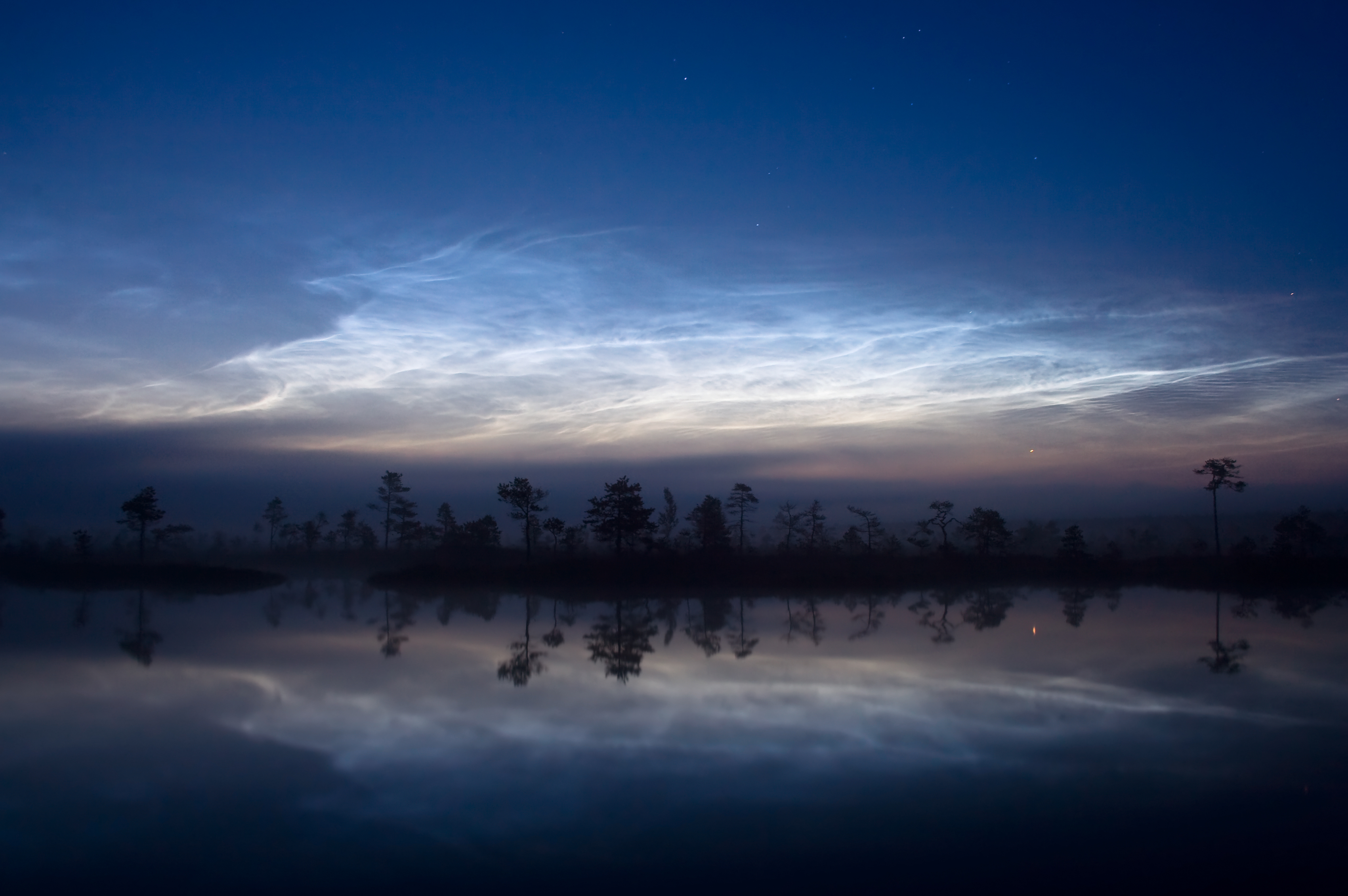 Noctilucent clouds are thin clouds that come in a variety of forms based from about and occasionally seen in deep twilight after sunset and before sunrise.
;Type 1 : Veils, very tenuous stratiform; resembles cirrostratus or poorly defined cirrus.
;Type 2 : Long stratocumuliform bands, often in parallel groups or interwoven at small angles. More widely spaced than cirrocumulus bands.
:;2A : Bands with diffuse, blurred edges.
:;2B : Bands with sharply defined edges.
;Type 3: Billows. Clearly spaced, fibrous cirriform, roughly parallel short streaks.
:;3A : Short, straight, narrow streaks.
:;3B : Wave-like structures with undulations.
;Type 4 : Whirls. Partial (or, more rarely, complete) cirriform rings with dark centers.
:;4A : Whirls possessing a small angular radius of curvature, sometimes resembling light ripples on a water surface.
:;4B : Simple curve of medium angular radius with one or more streaks.
:;4C : Whirls with large-scale ring structures.
Noctilucent clouds are thin clouds that come in a variety of forms based from about and occasionally seen in deep twilight after sunset and before sunrise.
;Type 1 : Veils, very tenuous stratiform; resembles cirrostratus or poorly defined cirrus.
;Type 2 : Long stratocumuliform bands, often in parallel groups or interwoven at small angles. More widely spaced than cirrocumulus bands.
:;2A : Bands with diffuse, blurred edges.
:;2B : Bands with sharply defined edges.
;Type 3: Billows. Clearly spaced, fibrous cirriform, roughly parallel short streaks.
:;3A : Short, straight, narrow streaks.
:;3B : Wave-like structures with undulations.
;Type 4 : Whirls. Partial (or, more rarely, complete) cirriform rings with dark centers.
:;4A : Whirls possessing a small angular radius of curvature, sometimes resembling light ripples on a water surface.
:;4B : Simple curve of medium angular radius with one or more streaks.
:;4C : Whirls with large-scale ring structures.
Polar stratospheric cloud identification and classification

Very high-level stratiform
;Nitric acid and water polar stratospheric : Sometimes known as type 1, a thin sheet-like cloud resembling cirrostratus or haze. Contains supercooled nitric acid and water droplets; sometimes also contains supercooledVery high-level cirriform and stratocumuliform
;Cloud identification and classification in the troposphere
Tropospheric clouds are divided into physical forms defined by structure, and levels defined by altitude range. These divisions are cross-classified to produce ten basic genus-types. They have Latin names as authorized by the World Meteorological Organization (WMO) that indicate physical structure, altitude or étage, and process of formation.High-level cirriform, stratocumuliform, and stratiform
High clouds form in the highest and coldest region of the troposphere from about 5 to 12 km (16,500 to 40,000 ft) in temperate latitudes. At this altitude water almost always freezes so high clouds are generally composed ofGenus cirrus
Abbreviation: Ci Cirriform clouds tend to be wispy and are mostly transparent or translucent. Isolated cirrus do not bring rain; however, large amounts of cirrus can indicate an approaching storm system eventually followed by fair weather. There are several variations of clouds of the cirrus genus based on species and varieties:=Species
=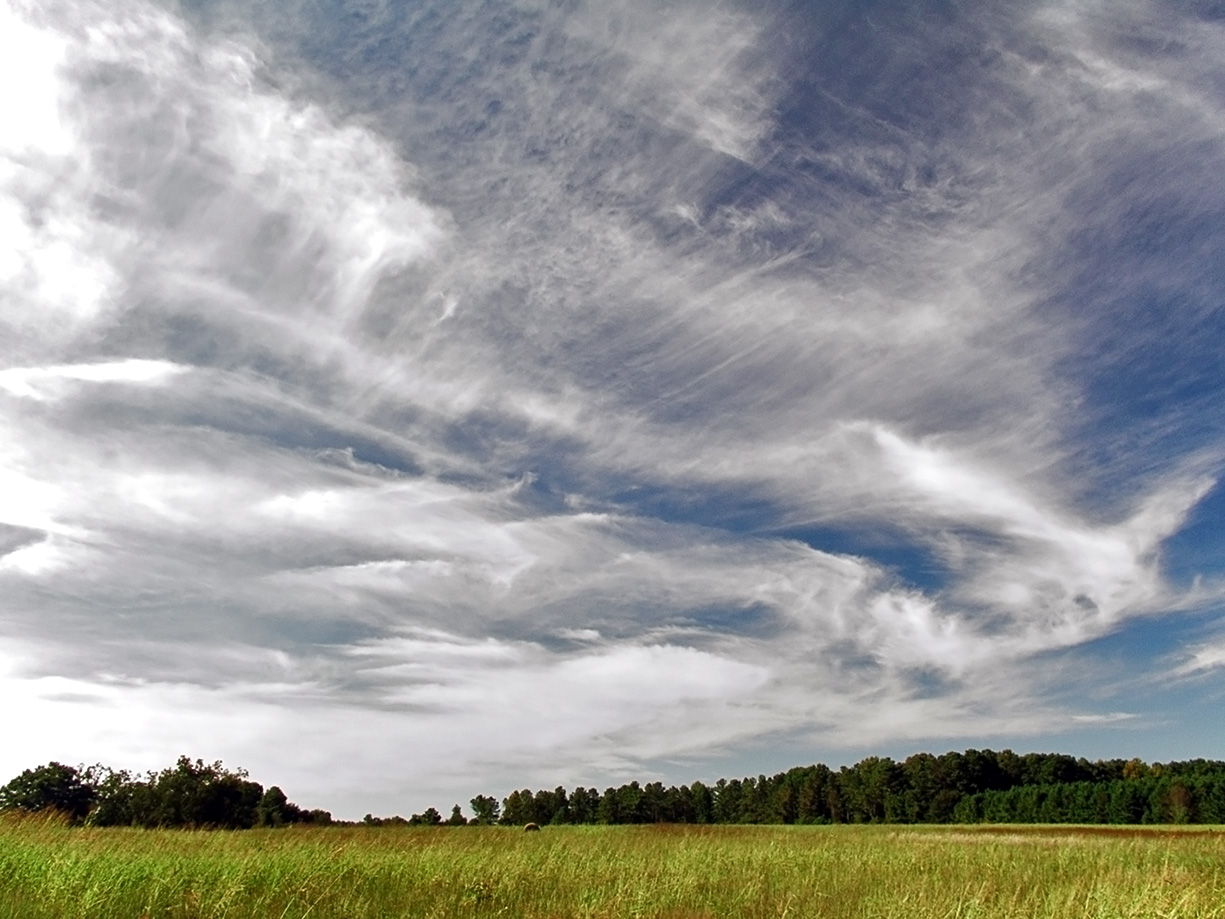
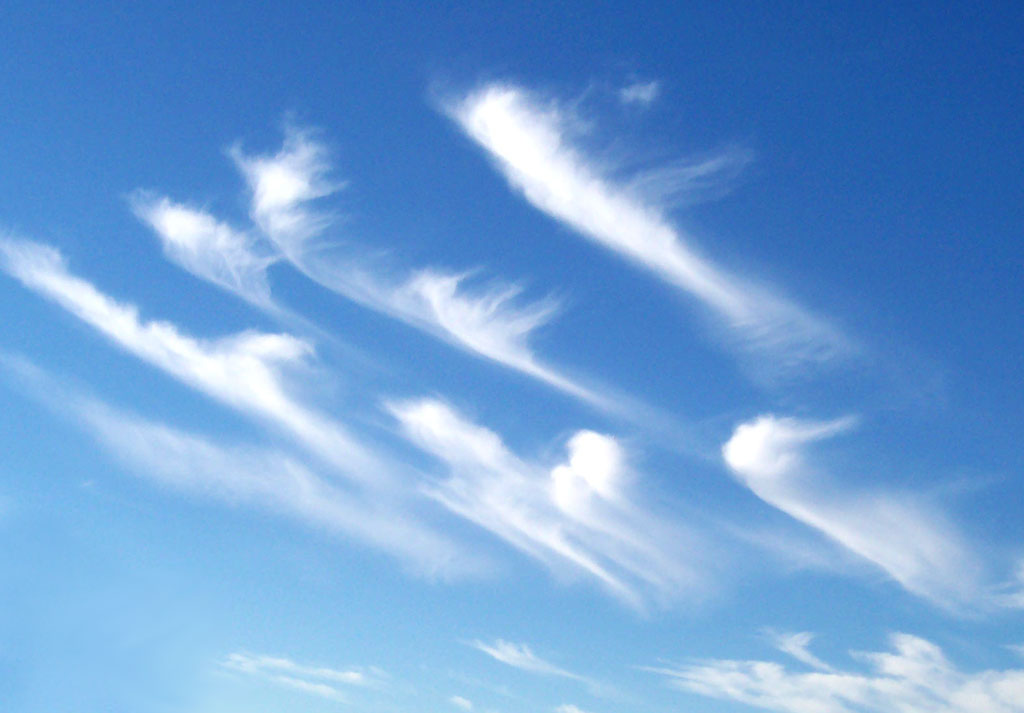 ; Cirrus fibratus (V-1): High clouds having the traditional "mare's tail" appearance. These clouds are long, fibrous, and curved, with no tufts or curls at the ends.
; Cirrus uncinus (V-2): Filaments with up-turned hooks or curls.
; Cirrus spissatus (V-3): Dense and opaque or mostly opaque patches.
; Cirrus castellanus (V-4): A series of dense lumps, or "towers", connected by a thinner base.
;
; Cirrus fibratus (V-1): High clouds having the traditional "mare's tail" appearance. These clouds are long, fibrous, and curved, with no tufts or curls at the ends.
; Cirrus uncinus (V-2): Filaments with up-turned hooks or curls.
; Cirrus spissatus (V-3): Dense and opaque or mostly opaque patches.
; Cirrus castellanus (V-4): A series of dense lumps, or "towers", connected by a thinner base.
; =Varieties
= ; Opacity-based: None; always translucent except species spissatus which is inherently opaque. ; Fibratus pattern-based: :; Cirrus fibratus intortus (V-6): Irregularly curved or tangled filaments. :; Cirrus fibratus vertebratus (V-7): Elements arranged in the manner of a vertebrate or fish=Supplementary features
= ; Precipitation-based: Not associated with cirrus. ; Cloud-based: :; Mamma: Bubble-like downward protuberances; mostly seen with species castellanus. ; Genitus mother clouds: :; Cirrus cirrocumulogenitus: :; Cirrus altocumulogenitus: :; Cirrus cumulonimbogenitus: :; Cirrus homogenitus: Cirrus formed by spreading of aircraft contrails. ; Mutatus mother cloud: :; Cirrus cirrostratomutatus: :; Cirrus homomutatus: Cirrus formed by the complete transformation of cirrus homogenitus.Genus cirrocumulus
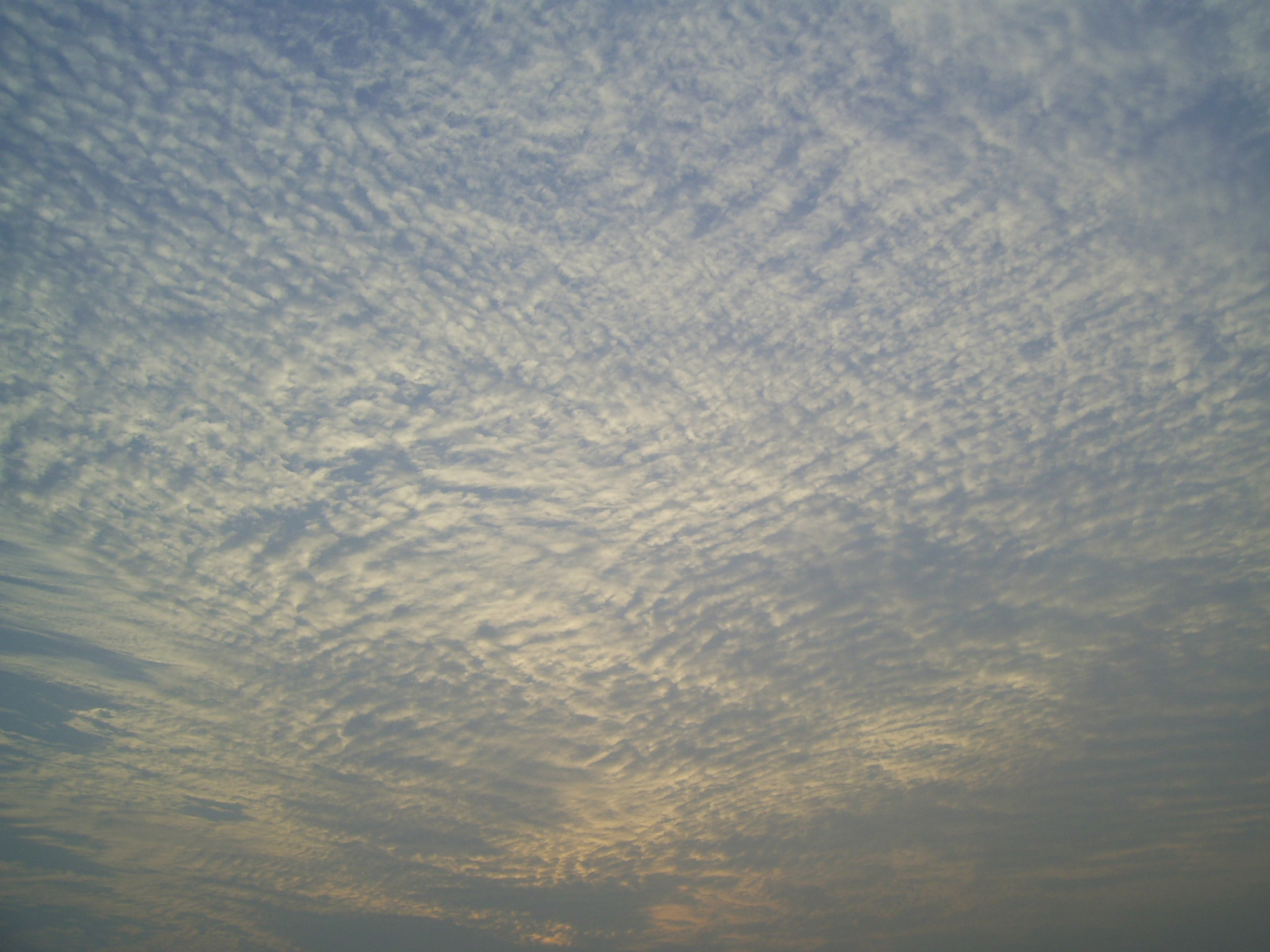 Abbreviation: Cc.
High-level stratocumuliform clouds of the genus cirrocumulus form when moist air at high tropospheric altitude reaches saturation, creating ice crystals or supercooled water droplets. Limited convective instability at the cloud level gives the cloud a rolled or rippled appearance. Despite the lack of a ''strato-'' prefix, layered cirrocumulus is physically a high stratocumuliform genus.Burroughs, William James; Crowder, Bob (January 2007). ''Weather'', p.216. Fog City Press, San Francisco. .
Abbreviation: Cc.
High-level stratocumuliform clouds of the genus cirrocumulus form when moist air at high tropospheric altitude reaches saturation, creating ice crystals or supercooled water droplets. Limited convective instability at the cloud level gives the cloud a rolled or rippled appearance. Despite the lack of a ''strato-'' prefix, layered cirrocumulus is physically a high stratocumuliform genus.Burroughs, William James; Crowder, Bob (January 2007). ''Weather'', p.216. Fog City Press, San Francisco. .
=High stratocumuliform species
= ;=Varieties
= ; Opacity-based varieties: None (always translucent). ; Pattern-based varieties: :; Undulatus: Cirrocumulus with an undulating base; normally associated with stratiformis and lenticularis species. ::; Stratocumuliform undulatus (V-16): ::; Cirrocumulus stratiformis undulatus (V-17): ::; Cirrocumulus lenticularis undulatus (V-18): :; Lacunosus: Cirrocumulus with large clear holes; normally associated with stratiformis and castellanus species (also with cumuliform floccus species). ::; Stratocumuliform lacunosus: ::; Cirrocumulus stratiformis lacunosus (V-19): ::; Cirrocumulus castellanus lacunosus (V-20): ::; Cirrocumulus floccus lacunosus (V-21):=Supplementary features
= ; Precipitation-based supplementary feature: :; Virga: Light precipitation that evaporates well above ground level; mostly seen with species stratiformis, castellanus, and floccus. ; Cloud-based supplementary feature: :; Mamma: Bubble-like downward protuberances; mostly seen with species castellanus. ; Genitus mother clouds: No genitus types. ; Mutatus mother clouds: :; Cirrocumulus cirromutatus :; Cirrocumulus cirrostratomutatus :; Cirrocumulus altocumulomutatus :; Cirrocumulus homomutatus: Results from the transformation of cirrus homogenitus.Genus cirrostratus
 Abbreviation: Cs
Abbreviation: Cs
 Clouds of the genus cirrostratus consist of mostly continuous, wide sheets of cloud that covers a large area of the sky. It is formed when convectively stable moist air cools to saturation at high altitude, forming ice crystals.Burroughs, William James; Crowder, Bob (January 2007). ''Weather'', p.215. Fog City Press, San Francisco. . Frontal cirrostratus is a precursor to rain or snow if it thickens into mid-level altostratus and eventually nimbostratus, as the weather front moves closer to the observer.
Clouds of the genus cirrostratus consist of mostly continuous, wide sheets of cloud that covers a large area of the sky. It is formed when convectively stable moist air cools to saturation at high altitude, forming ice crystals.Burroughs, William James; Crowder, Bob (January 2007). ''Weather'', p.215. Fog City Press, San Francisco. . Frontal cirrostratus is a precursor to rain or snow if it thickens into mid-level altostratus and eventually nimbostratus, as the weather front moves closer to the observer.
=Species
= ; Cirrostratus fibratus (V-22): Cirrostratus sheet with a fibrous appearance, but not as detached as cirrus. ;=Varieties
= ; Opacity-based varieties: None (always translucent) ; Fibratus pattern-based varieties: :; Cirrostratus fibratus duplicatus (V-24): Separate or semi-merged sheets with one layer slightly above the other. :; Cirrostratus fibratus undulatus (V-25): Undulating waves. ; Varieties are not commonly associated with Cs species nebulosus.=Supplementary features
= : Supplementary features/accessory clouds: Not associated with cirrostratus. ; Genitus mother clouds: :; Cirrostratus cirrocumulogenitus: :; Cirrostratus cumulonimbogenitus: ; Mutatus mother clouds: :; Cirrostratus cirromutatus: :; Cirrostratus cirrocumulomutatus: :; Cirrostratus altostratomutatus: :; Cirrostratus homomutatus: Results from the transformation of cirrus homogenitus.Mid-level stratocumuliform and stratiform
Middle cloud forms from 2 to 7 km (6,500–23,000 ft) in temperate latitudes, and may be composed of water droplets or ice crystals depending on the temperature profile at that altitude range.Genus altocumulus


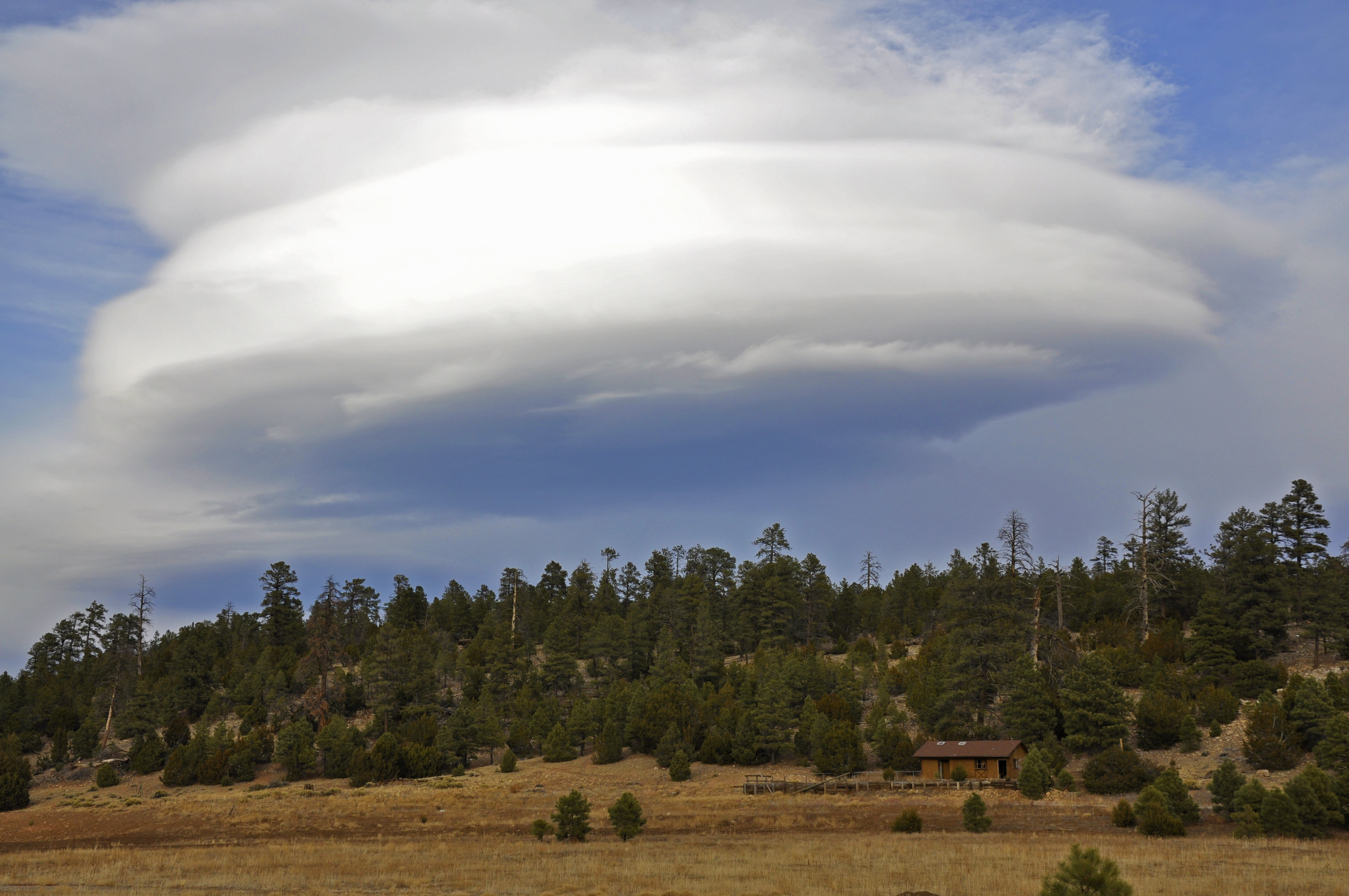

 Abbreviation: Ac
Mid-level stratocumuliform clouds of the genus altocumulus are not always associated with a weather front but can still bring precipitation, usually in the form of virga which does not reach the ground. Layered forms of altocumulus are generally an indicator of limited convective instability, and are therefore mainly stratocumuliform in structure.
Abbreviation: Ac
Mid-level stratocumuliform clouds of the genus altocumulus are not always associated with a weather front but can still bring precipitation, usually in the form of virga which does not reach the ground. Layered forms of altocumulus are generally an indicator of limited convective instability, and are therefore mainly stratocumuliform in structure.
=Mid-level stratocumuliform species
= ; Altocumulus stratiformis: Always dividable into opacity-based varieties. Sheets or relatively flat patches of altocumulus. ; Altocumulus lenticularis (V-26): Lens-shaped middle cloud. Includes informal variant altocumulus Kelvin–Helmholtz cloud, lenticular spiral indicative of severe turbulence. ;=Varieties
= ; Opacity-based varieties: :; Altocumulus stratiformis translucidus (V-30): Translucent altocumulus through which the sun or moon can be seen. :; Altocumulus stratiformis perlucidus (V-31): Opaque middle clouds with translucent breaks. :; Altocumulus stratiformis opacus (V-32): Opaque altocumulus that obscures the sun or moon. ; Pattern-based varieties: :; Radiatus: Rows of altocumulus that appear to converge at the horizon; normally associated with stratiformis species. ::; Altocumulus stratiformis translucidus radiatus (V-33): ::; Altocumulus stratiformis perlucidus radiatus (V-34): ::; Altocumulus stratiformis opacus radiatus (V-35): :; Duplicatus: Altocumulus in closely spaced layers, one above the other; normally associated with stratiformis and lenticularis species. ::; Altocumulus stratiformis translucidus duplicatus (V-36): ::; Altocumulus stratiformis perlucidus duplicatus (V-37): ::; Altocumulus stratiformis opacus duplicatus (V-38): ::; Altocumulus lenticularis duplicatus (V-39): :; Undulatus: Altocumulus with wavy undulating base; normally associated with stratiformis and lenticularis species. ::; Altocumulus stratiformis translucidus undulatus (V-40): ::; Altocumulus stratiformis perlucidus undulatus (V-41): ::; Altocumulus stratiformis opacus undulatus (V-42): ::; Altocumulus lenticularis undulatus (V-43): :; Lacunosus: Altocumulus with circular holes caused by localized downdrafts; normally associated with stratiformis and castellanus species (also with cumuliform floccus species). ::; Altocumulus stratiformis translucidus lacunosus (V-44): ::; Altocumulus stratiformis perlucidus lacunosus (V-45): ::; Altocumulus stratiformis opacus lacunosus (V-46): ::; Altocumulus castellanus lacunosus (V-47): ::; Altocumulus floccus lacunosus (V-48):=Supplementary features
= ; Precipitation-based supplementary feature: :; Virga: Altocumulus producing precipitation that evaporates before reaching the ground; usually associated with species stratiformis, castellanus, and floccus. ; Cloud-based supplementary feature: :; Mamma: Altocumulus (usually species castellanus) with downward facing bubble-like protuberances caused by localized downdrafts within the cloud. ; Genitus mother clouds: :; Altocumulus cumulogenitus: :; Altocumulus cumulonimbogenitus: ; Mutatus mother clouds: :; Altocumulus cirrocumulomutatus: :; Altocumulus altostratomutatus: :; Altocumulus nimbostratomutatus: :; Altocumulus stratocumulomutatus:Genus altostratus
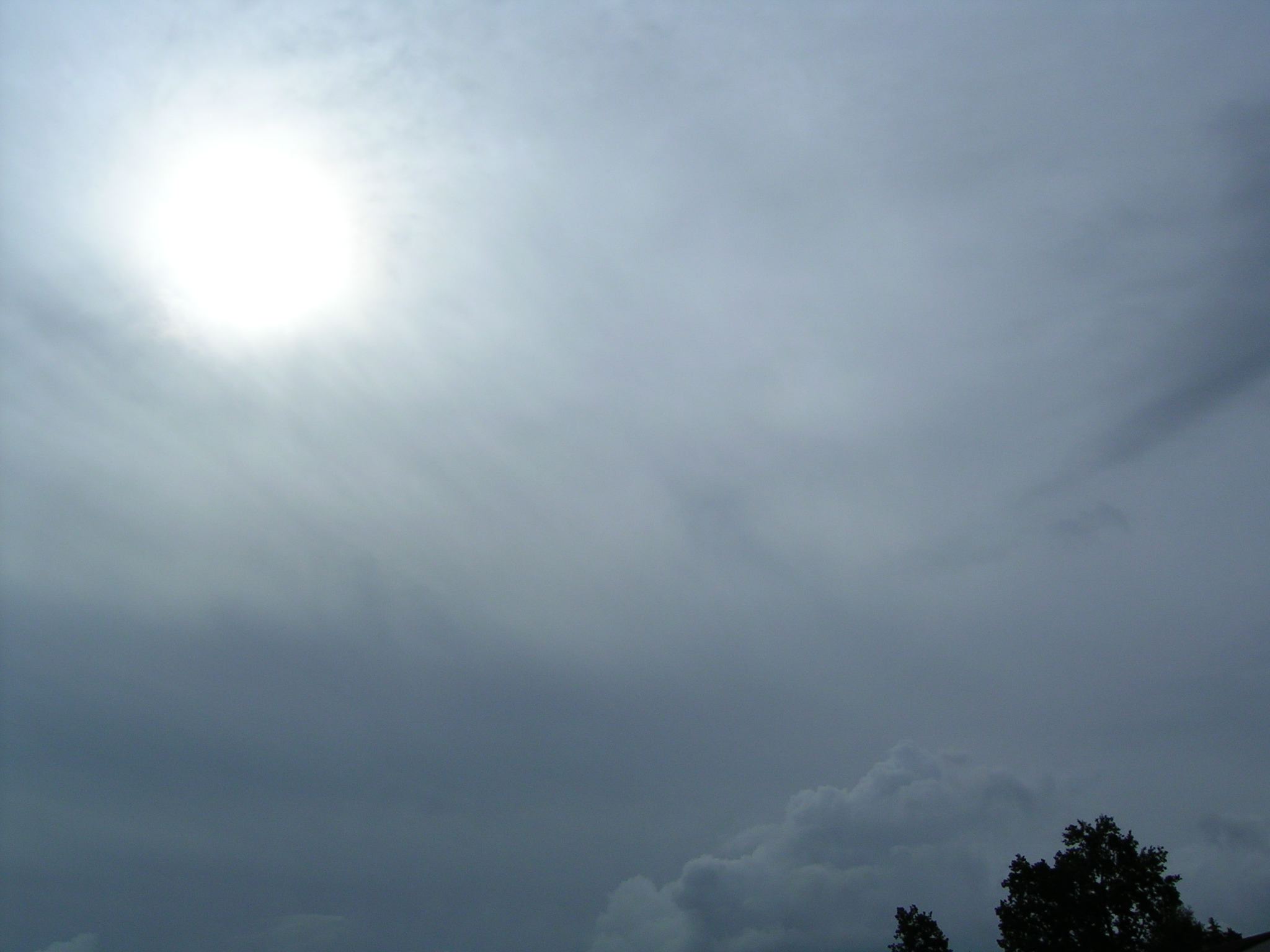 Abbreviation: As
Stratiform clouds of the genus altostratus form when a large convectively stable airmass is lifted to condensation in the middle level of the troposphere, usually along a frontal system. Altostratus can bring light rain or snow. If the precipitation becomes continuous, it may thicken into nimbostratus which can bring precipitation of moderate to heavy intensity.
Abbreviation: As
Stratiform clouds of the genus altostratus form when a large convectively stable airmass is lifted to condensation in the middle level of the troposphere, usually along a frontal system. Altostratus can bring light rain or snow. If the precipitation becomes continuous, it may thicken into nimbostratus which can bring precipitation of moderate to heavy intensity.
=Species
= No differentiated species (always nebulous).=Varieties
= ; Opacity-based varieties: :; Altostratus translucidus (V-49): Altostratus through which the sun can be seen. :; Altostratus opacus (V-50): Altostratus that completely blocks out the sun. ; Pattern-based variety radiatus: Bands that appear to converge at the horizon. :; Altostratus translucidus radiatus (V-51): :; Altostratus opacus radiatus (V-52): ; Pattern-based variety duplicatus: Altostratus in closely spaced layers, one above the other. :; Altostratus translucidus duplicatus (V-53): :; Altostratus opacus duplicatus (V-54): ; Pattern-based variety undulatus: Altostratus with wavy undulating base. :; Altostratus translucidus undulatus (V-55): :; Altostratus opacus undulatus (V-56):=Supplementary features
= ; Precipitation-based supplementary features: :; Virga: Accompanied by precipitation that evaporates before reaching the ground. Seen mostly with opacus varieties. :; Praecipitatio: Produces precipitation that reaches the ground; associated with opacus varieties. ; Cloud-based supplementary feature: :; Mamma: Altostratus with downward facing bubble-like protuberances caused by localized downdrafts within the cloud. ;Towering vertical cumulonimbiform and cumuliform (low to mid-level cloud base)
Clouds with upward-growing vertical development usually form below , but can be based as high as in temperate climates, and often much higher in arid regions.Genus cumulonimbus: Towering vertical

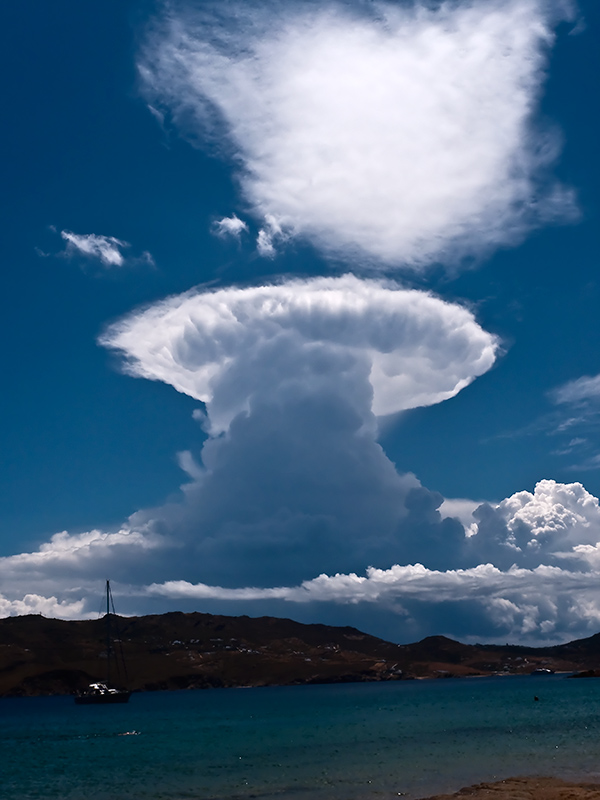 Abbreviation: Cb
Clouds of the genus cumulonimbus have very-dark-gray-to-nearly-black flat bases and very high tops that can penetrate the tropopause. They develop from cumulus when the airmass is convectively highly unstable. They generally produce thunderstorms, rain or
Abbreviation: Cb
Clouds of the genus cumulonimbus have very-dark-gray-to-nearly-black flat bases and very high tops that can penetrate the tropopause. They develop from cumulus when the airmass is convectively highly unstable. They generally produce thunderstorms, rain or =Species
= ; Cumulonimbus calvus (V-57): Cumulonimbus with high domed top. ; Cumulonimbus capillatus (V-58): Towering vertical cloud with high cirriform top.=Varieties
= No varieties (always opaque and does not form in patterns visible from surface level).=Supplementary features
= ; Precipitation-based supplementary features: Associated with calvus and capillatus species. :; Virga: Precipitation that evaporates before reaching the ground. :; Praecipitatio: Precipitation that reaches the ground. ; Cloud-based supplementary features: :;Genus cumulus: Towering vertical
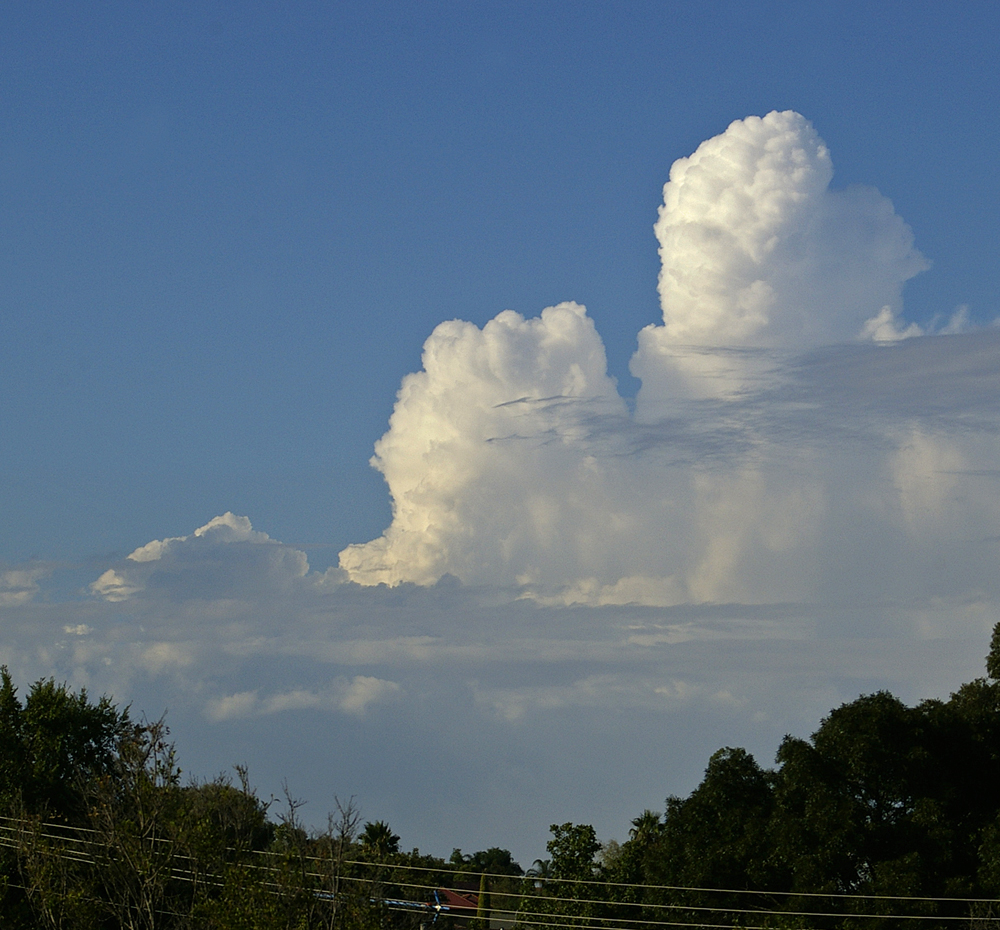 Abbreviations: Cu con (''cumulus congestus'') or Tcu (''towering cumulus'')
Abbreviations: Cu con (''cumulus congestus'') or Tcu (''towering cumulus'')
=Species
= ; Cumulus congestus (V-59): These large cumulus clouds have flat dark grey bases and very tall tower-like formations with tops mostly in the high level of the troposphere. The International Civil Aviation Organization (ICAO) designates this species as towering cumulus (Tcu).=Varieties
= ; Opacity-based varieties: None (always opaque). ; Pattern-based variety: None (not generally discerned with highly unstable cumulus congestus).=Supplementary features
= ; Precipitation-based supplementary features: :; Virga: Accompanied by precipitation that evaporates before reaching the ground. :; Praecipitatio: Produces precipitation that reaches the ground. ; Cloud-based supplementary features: :; Mamma: Downward facing bubble-like protuberances caused by localized downdrafts within the cloud. :; Arcus (including roll andMulti-level stratiform and moderate vertical cumuliform (low to mid-level cloud base)
Genus nimbostratus: Multi-level
=Species
= No differentiated species (always nebulous).=Varieties
= No varieties (always opaque and never forms in patterns).=Supplementary features
= ; Precipitation-based supplementary features: :; Virga: Accompanied by precipitation that evaporates before reaching the ground. :; Praecipitatio: Produces precipitation that reaches the ground. ;Genus cumulus: Moderate vertical


 Abbreviation: Cu
Moderate vertical cumulus is the product of free convective airmass instability. Continued upward growth suggests showers later in the day.
Abbreviation: Cu
Moderate vertical cumulus is the product of free convective airmass instability. Continued upward growth suggests showers later in the day.
=Species
= ; Cumulus mediocris (V-61): Moderate vertical clouds with flat medium grey bases and higher tops than cumulus humilis.=Varieties
= : Opacity-based varieties: None (always opaque) ; Pattern-based variety: :; Cumulus mediocris radiatus (V-62)(V-60); Moderate cumulus clouds arranged in parallel lines that appear to converge at the horizon.=Supplementary features
= : Precipitation-based supplementary features: :; Virga: Accompanied by precipitation that evaporates before reaching the ground. :; Praecipitatio: Produces precipitation that reaches the ground. ; Cloud-based supplementary feature: :; Mamma: Downward facing bubble-like protuberances caused by localized downdrafts within the cloud. ;Low-level stratocumuliform, cumuliform, and stratiform
Low cloud forms from near surface to ca. and are generally composed of water droplets.Genus stratocumulus
=Species
= ; Stratocumulus stratiformis: Always dividable into opacity-based varieties. Sheets or relatively flat patches of stratocumulus ; Stratocumulus lenticularis (V-63): Lens-shaped low cloud. ;=Varieties
= ; Stratocumuliform opacity-based varieties: :; Stratocumulus stratiformis translucidus (V-67): Thin translucent stratocumulus through which the sun or moon can be seen. :; Stratocumulus stratiformis perlucidus (V-68): Opaque low clouds with translucent breaks. :; Stratocumulus stratiformis opacus (V-69): Opaque stratocumulus clouds. ; Pattern-based variety radiatus: Stratocumulus arranged in parallel bands that appear to converge on the horizon; normally associated with stratiformis species. :; Stratocumulus stratiformis translucidus radiatus (V-70): :; Stratocumulus stratiformis perlucidus radiatus (V-71): :; Stratocumulus stratiformis opacus radiatus (V-72): ; Pattern-based variety duplicatus: Closely spaced layers of stratocumulus, one above the other; normally associated with stratiformis and lenticularis species. :; Stratocumulus stratiformis translucidus duplicatus (V-73): :; Stratocumulus stratiformis perlucidus duplicatus (V-74): :; Stratocumulus stratiformis opacus duplicatus (V-75): :; Stratocumulus lenticularis duplicatus (V-76): ; Pattern-based variety undulatus: Stratocumulus with wavy undulating base; normally associated with stratiformis and lenticularis species. :; Stratocumulus stratiformis translucidus undulatus (V-77): :; Stratocumulus stratiformis perlucidus undulatus (V-78): :; Stratocumulus stratiformis opacus undulatus (V-79): :; Stratocumulus lenticularis undulatus (V-80): ; Pattern-based variety lacunosus: Sc with circular holes caused by localized downdrafts; normally associated with stratiformis and castellanus species. :; Stratocumulus stratiformis translucidus lacunosus (V-81): :; Stratocumulus stratiformis perlucidus lacunosus (V-82): :; Stratocumulus stratiformis opacus lacunosus (V-83): :; Stratocumulus castellanus lacunosus (V-84): :; Stratocumulus floccus lacunosus (V-85):=Supplementary features
= ; Precipitation-based supplementary features: Usually associated with species stratiformis and castellanus. :; Virga: Low cloud producing precipitation that evaporates before reaching the ground. :; Praecipitatio: Stratocumulus clouds producing precipitation that reaches the ground. ; Cloud-based supplementary feature: :; Mamma: Stratocumulus with bubble-like protrusions on the underside; usually associated with species castellanus. ; Genitus mother clouds: :; Stratocumulus cumulogenitus: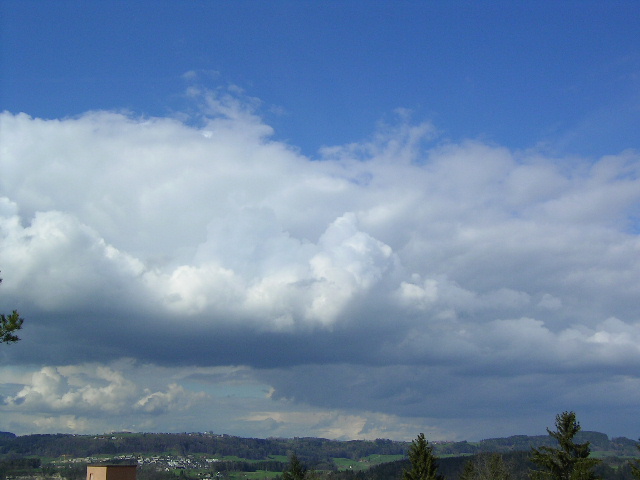 :; Stratocumulus nimbostratogenitus:
:; Stratocumulus cumulonimbogenitus:
:; Stratocumulus altostratogenitus:
; Mutatus mother clouds:
:; Stratocumulus nimbostratomutatus:
:; Stratocumulus altocumulomutatus:
:; Stratocumulus stratomutatus:
:; Stratocumulus nimbostratogenitus:
:; Stratocumulus cumulonimbogenitus:
:; Stratocumulus altostratogenitus:
; Mutatus mother clouds:
:; Stratocumulus nimbostratomutatus:
:; Stratocumulus altocumulomutatus:
:; Stratocumulus stratomutatus:
Genus cumulus (little vertical extent)
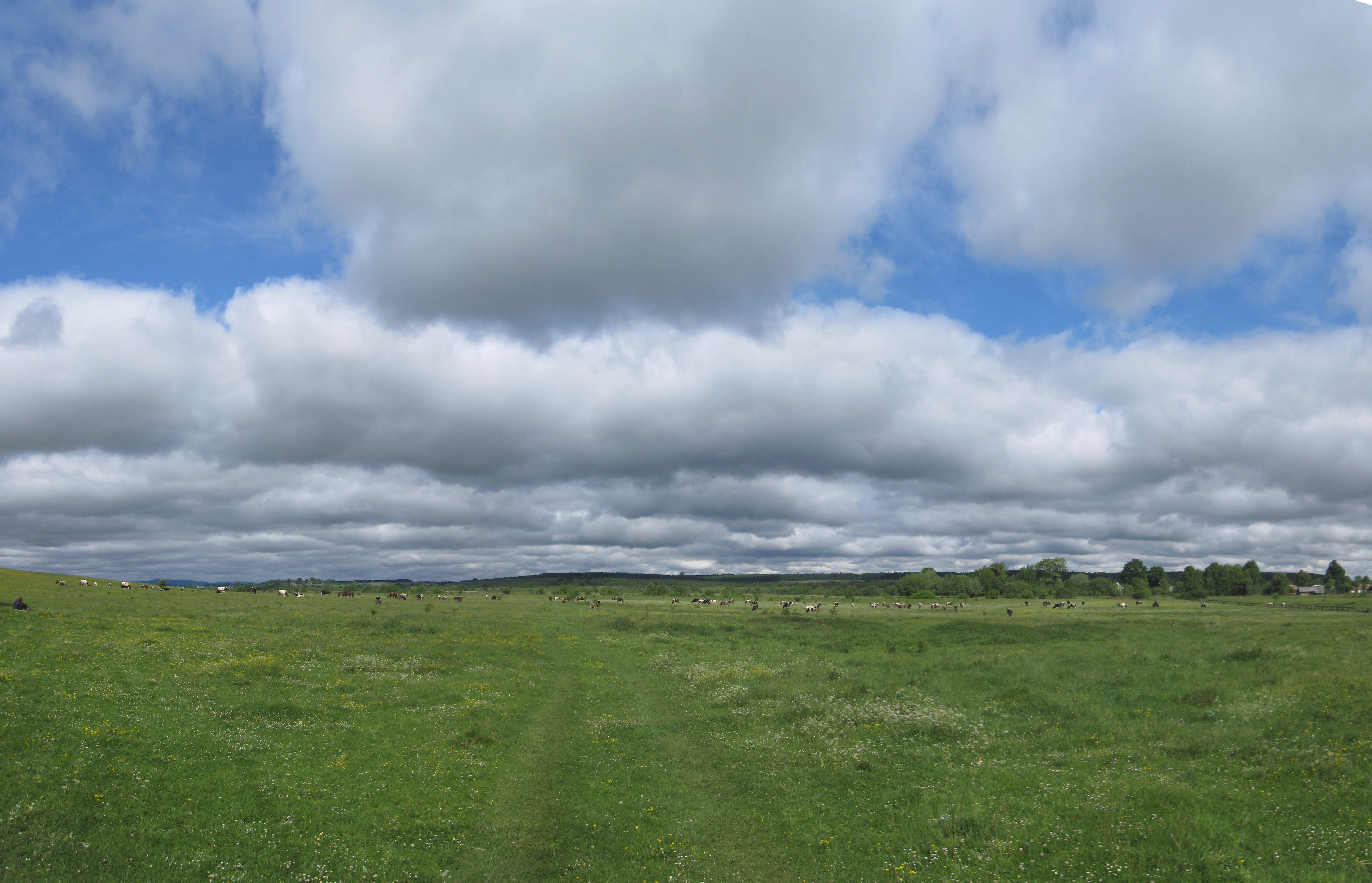 Abbreviation: Cu
These are fair weather cumuliform clouds of limited convection that do not grow vertically. The vertical height from base to top is generally less than the width of the cloud base. They appear similar to stratocumulus but the elements are generally more detached and less wide at the base.
Abbreviation: Cu
These are fair weather cumuliform clouds of limited convection that do not grow vertically. The vertical height from base to top is generally less than the width of the cloud base. They appear similar to stratocumulus but the elements are generally more detached and less wide at the base.
=Species
= ; Cumulus fractus (V-86): Ragged shreds of cumulus clouds. ; Cumulus humilis (V-87): "Fair weather clouds" with flat light grey bases and small white domed tops.=Varieties
= ; Opacity-based varieties: None (always opaque except species fractus which is always translucent). ; Humilis pattern-based variety: :; Cumulus humilis radiatus (V-88): Small cumulus clouds arranged in parallel lines that appear to converge at the horizon.= Supplementary features and accessory clouds
= Not commonly seen with cumulus fractus or humilis. ; Genitus mother clouds :; Cumulus stratocumulogenitus :; Cumulus homogenitus: Clouds formed by air-mass convection associated with contained industrial activity. ; Mutatus mother clouds :; Cumulus stratocumulomutatus :; Cumulus stratomutatus ;; Cumulus cataractagenitus: Generated by the spray from waterfalls.Genus stratus

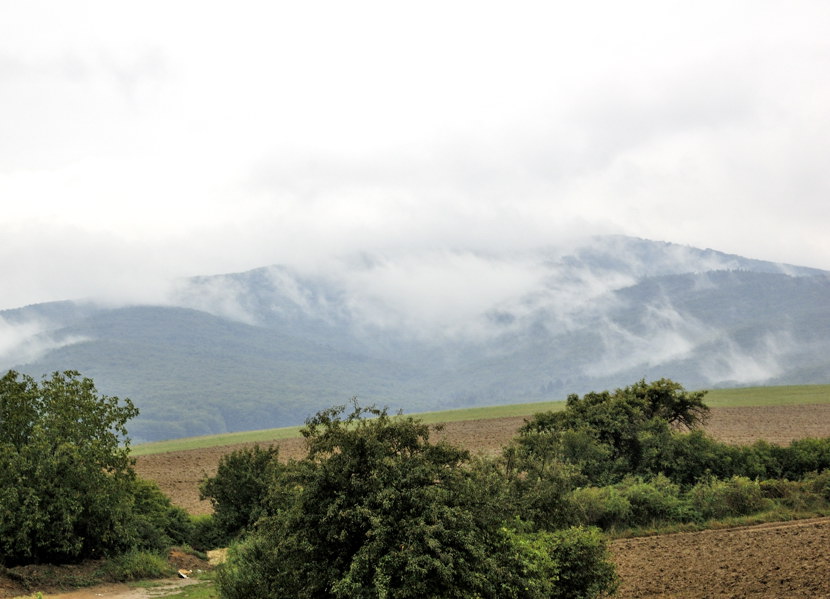 Abbreviation: St
Clouds of the genus stratus form in low horizontal layers having a ragged or uniform base. Ragged stratus often forms in precipitation while more uniform stratus forms in maritime or other moist stable air mass conditions. The latter often produces drizzle. Stratus that touches the Earth's surface is given the common name,
Abbreviation: St
Clouds of the genus stratus form in low horizontal layers having a ragged or uniform base. Ragged stratus often forms in precipitation while more uniform stratus forms in maritime or other moist stable air mass conditions. The latter often produces drizzle. Stratus that touches the Earth's surface is given the common name, =Species
= ; Stratus nebulosus: Uniform fog-like low cloud. ;=Varieties
= ; Nebulosus opacity-based varieties: :; Stratus nebulosus translucidus (V-90): Thin translucent stratus. :; Stratus nebulosus opacus (V-91): Opaque stratus that obscures the sun or moon. ; Pattern-based variety undulatus: Wavy undulating base. :; Stratus nebulosus translucidus undulatus (V-92) :; Stratus nebulosus opacus undulatus (V-93) ; Varieties are not commonly associated with St species fractus.=Supplementary features
= ; Precipitation-based supplementary feature: :; Praecipitatio: Stratus (usually species nebulosus) producing precipitation. ; Accessory clouds: Not usually seen with stratus. ; Genitus mother clouds and other mother sources: :; Stratus nimbostratogenitus :; Stratus cumulogenitus :; Stratus cumulonimbogenitus :; Stratus cataractagenitus: Generated by the spray from waterfalls. :; Stratus silvagenitus: A stratus cloud that forms as water vapor is added to the air above a forest. :; Stratus homogenitus ; Mutatus mother cloud: :; Stratus stratocumulomutatusTropospheric cloud types with Latin etymologies where applicable
''Cloud types are sorted in alphabetical order except where noted''.WMO genera
; Altocumulus (''altus'' and ''cumulus''): Latin for "high heap": Applied to mid-level stratocumuliform. ; Altostratus (''altus'' and ''stratus''): "High sheet": Applied to mid-level stratiform. ; Cirrocumulus (''cirrus'' and ''cumulus''): "Hair-like heap": Applied to high-level stratocumuliform. ; Cirrostratus (''cirrus'' and ''stratus''): "Hair-like sheet": Applied to high-level stratiform. ; Cirrus: "Hair-like": Applied to high-level cirriform. ; Cumulonimbus (''cumulus'' and ''nimbus''): "Precipitation-bearing heap": Applied to vertical/multi-level cumulonimbiform. ; Cumulus: "Heap": Applied to low-level and vertical/multi-level cumuliform. ; Nimbostratus (''nimbus'' and ''stratus''): "Precipitation-bearing sheet": Applied to multi-level stratiform with vertical extent that produces precipitation of significant intensity. ; Stratocumulus (''stratus'' and ''cumulus''): "Sheet-like heap": Applied to low-level stratocumuliform. ; Stratus: "Sheet": Applied to low-level mostly shallow stratiform.WMO species
; Castellanus (Cas): Latin for "castle-like": Applies to stratocumuliform (Sc cas, Ac cas, Cc cas) and dense cirriform (Ci cas) with a series of ; Mediocris (Med): "Medium-size": Cumuliform (Cu med) with moderate vertical extent; indicates moderate instability and upcurrents.
; Nebulosus (Neb): "Nebulous": Indistinct low and high stratiform (St neb, Cs neb) without features; indicates light wind if any and stable air mass.
; Spissatus (Spi): "Dense": Thick cirriform (Ci spi) with a grey appearance; indicates some upward movement of air in the upper troposphere.
; Stratiformis (Str): "Sheet-like": Horizontal cloud sheet of flattened stratocumuliform (Sc str, Ac str, Cc str); indicates very slight airmass instability.
; Uncinus (Unc): "Hook-like": Cirriform (Ci unc) with a hook shape at the top; indicates a nearby backside of a weather system.
; Volutus (Vol): "Rolled": Elongated, low or mid-level, tube shaped, stratocumuliform (Sc vol, Ac vol).
The division of genus types into species is as shown in the following table. The genus types (including some cumulus sub-types) are arranged from top to bottom in the left column in approximate descending order of average overall altitude range. The species are sorted from left to right in approximate ascending order of instability or vertical extent of the forms to which each belongs:
# Stratiform species,
# Cirriform species,
# Stratocumuliform species,
# Cumuliform species,
# Cumulonimbiform species.
These ordinal instability numbers appear in each box where a particular genus has a particular species.
; Mediocris (Med): "Medium-size": Cumuliform (Cu med) with moderate vertical extent; indicates moderate instability and upcurrents.
; Nebulosus (Neb): "Nebulous": Indistinct low and high stratiform (St neb, Cs neb) without features; indicates light wind if any and stable air mass.
; Spissatus (Spi): "Dense": Thick cirriform (Ci spi) with a grey appearance; indicates some upward movement of air in the upper troposphere.
; Stratiformis (Str): "Sheet-like": Horizontal cloud sheet of flattened stratocumuliform (Sc str, Ac str, Cc str); indicates very slight airmass instability.
; Uncinus (Unc): "Hook-like": Cirriform (Ci unc) with a hook shape at the top; indicates a nearby backside of a weather system.
; Volutus (Vol): "Rolled": Elongated, low or mid-level, tube shaped, stratocumuliform (Sc vol, Ac vol).
The division of genus types into species is as shown in the following table. The genus types (including some cumulus sub-types) are arranged from top to bottom in the left column in approximate descending order of average overall altitude range. The species are sorted from left to right in approximate ascending order of instability or vertical extent of the forms to which each belongs:
# Stratiform species,
# Cirriform species,
# Stratocumuliform species,
# Cumuliform species,
# Cumulonimbiform species.
These ordinal instability numbers appear in each box where a particular genus has a particular species.
WMO varieties
; Opacity-based: :; Opacus: Latin for "Opaque". A thick sheet of stratiform or stratocumuliform cloud. :; Perlucidus: "Semi-transparent". Sheet of stratocumuliform cloud with small spaces between elements. :; Translucidus: "Translucent". Thin translucent patch or sheet of stratiform or stratocumuliform. ; Pattern-based: :; Duplicatus: Latin for "Double". Closely spaced often partly merged layers of cloud in one of several possible forms. :; Intortus: "Twisted". Curved and tangled cirriform. :; Lacunosus: "Full of holes". Thin stratocumuliform cloud distinguished by holes and ragged edges. :; Radiatus: "Radial". Clouds in one of several possible forms arranged in parallel lines that appear to converge at a central point near the horizon. :; Undulatus: "Wavy". Stratiform or stratocumuliform cloud displaying an undulating pattern. :; Vertebratus: "In the form of a back-bone". Cirriform arranged to look like the back-bone of a vertebrate. The following table shows the cloud varieties arranged across the top of the chart from left to right in approximate descending order of frequency of appearance. The genus types and some sub-types associated with each variety are sorted in the left column from top to bottom in approximate descending order of average overall altitude range. Where applicable, the genera and varieties are cross-classified to show the species normally associated with each combination of genus and variety. The exceptions comprise the following: Altostratus that have varieties but no species so the applicable boxes are marked without specific species names; cumulus congestus, a species that has its own altitude characteristic but no varieties; cumulonimbus that have species but no varieties, and nimbostratus that has no species or varieties. The boxes for genus and species combinations that have no varieties are left blank.WMO supplementary features
; Precipitation-based supplementary features: :; Praecipitatio: Latin for "falling": Cloud whose precipitation reaches the ground. :; Virga: "Twig" or "branch": Cloud whose precipitation evaporates before reaching the ground.
:; Virga: "Twig" or "branch": Cloud whose precipitation evaporates before reaching the ground.
 ; Cloud-based supplementary features:
:;
; Cloud-based supplementary features:
:;  :; Asperitas: "Roughness": A highly disturbed and chaotic wave feature occasionally seen with a stratocumulus or altocumulus cloud.
:; Asperitas: "Roughness": A highly disturbed and chaotic wave feature occasionally seen with a stratocumulus or altocumulus cloud.
 :; Cavum: "Hole": Supercooled altocumulus or cirrocumulus distinguished by a hole with ragged edges and virga or wisps of cirrus.
:; Cavum: "Hole": Supercooled altocumulus or cirrocumulus distinguished by a hole with ragged edges and virga or wisps of cirrus.
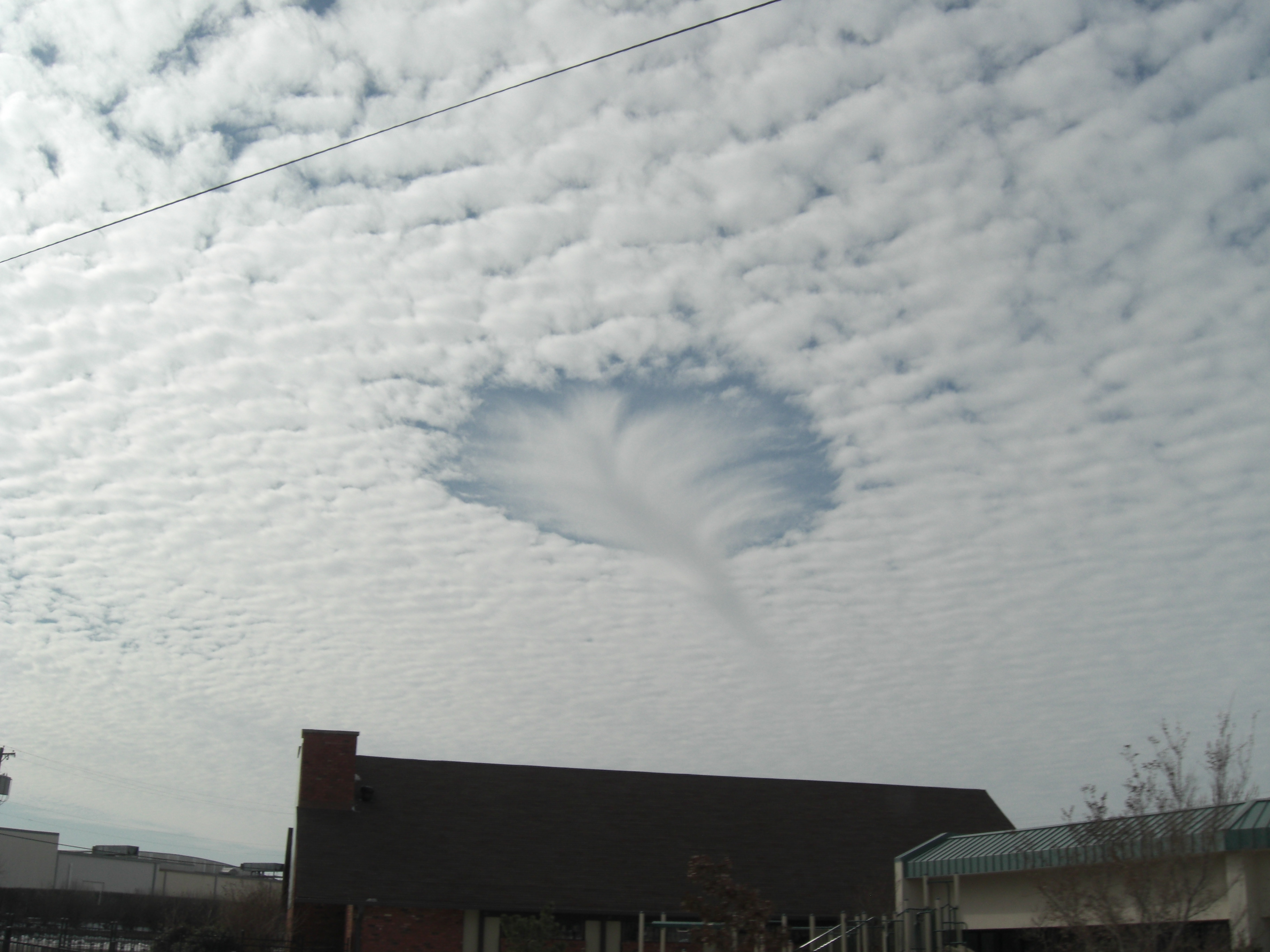 :; Cauda: "Tail": A tail cloud that extends horizontally away from the murus cloud and is the result of air feeding into the storm.
:; Cauda: "Tail": A tail cloud that extends horizontally away from the murus cloud and is the result of air feeding into the storm.
 :; Fluctus: Crested wave-like stratocumulus, altocumulus, or cirrus cloud formed by wind-shear.
:; Fluctus: Crested wave-like stratocumulus, altocumulus, or cirrus cloud formed by wind-shear.
 :; Incus: "Anvil": Top part of a mature cumulonimbus cloud; anvil-shaped feature.
:; Incus: "Anvil": Top part of a mature cumulonimbus cloud; anvil-shaped feature.
 :;
:; 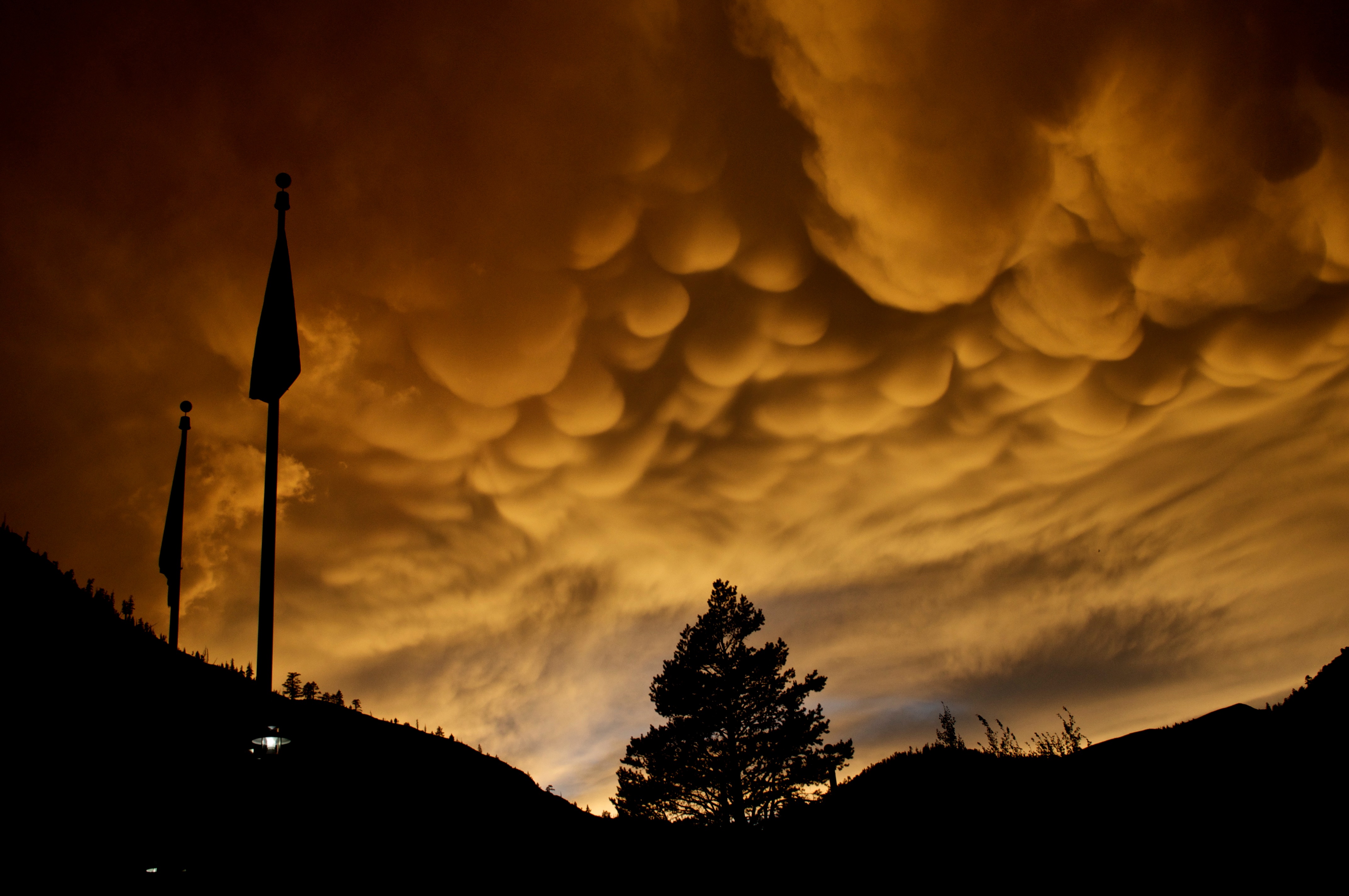 :; Murus: "Wall": Cumulonimbus wall cloud with a lowering rotating base that can portend tornadoes.
:; Murus: "Wall": Cumulonimbus wall cloud with a lowering rotating base that can portend tornadoes.
 :; Tuba: "Funnel" or "tube": Feature in the form of a column hanging from the bottom of cumulus or cumulonimbus.
:; Tuba: "Funnel" or "tube": Feature in the form of a column hanging from the bottom of cumulus or cumulonimbus.
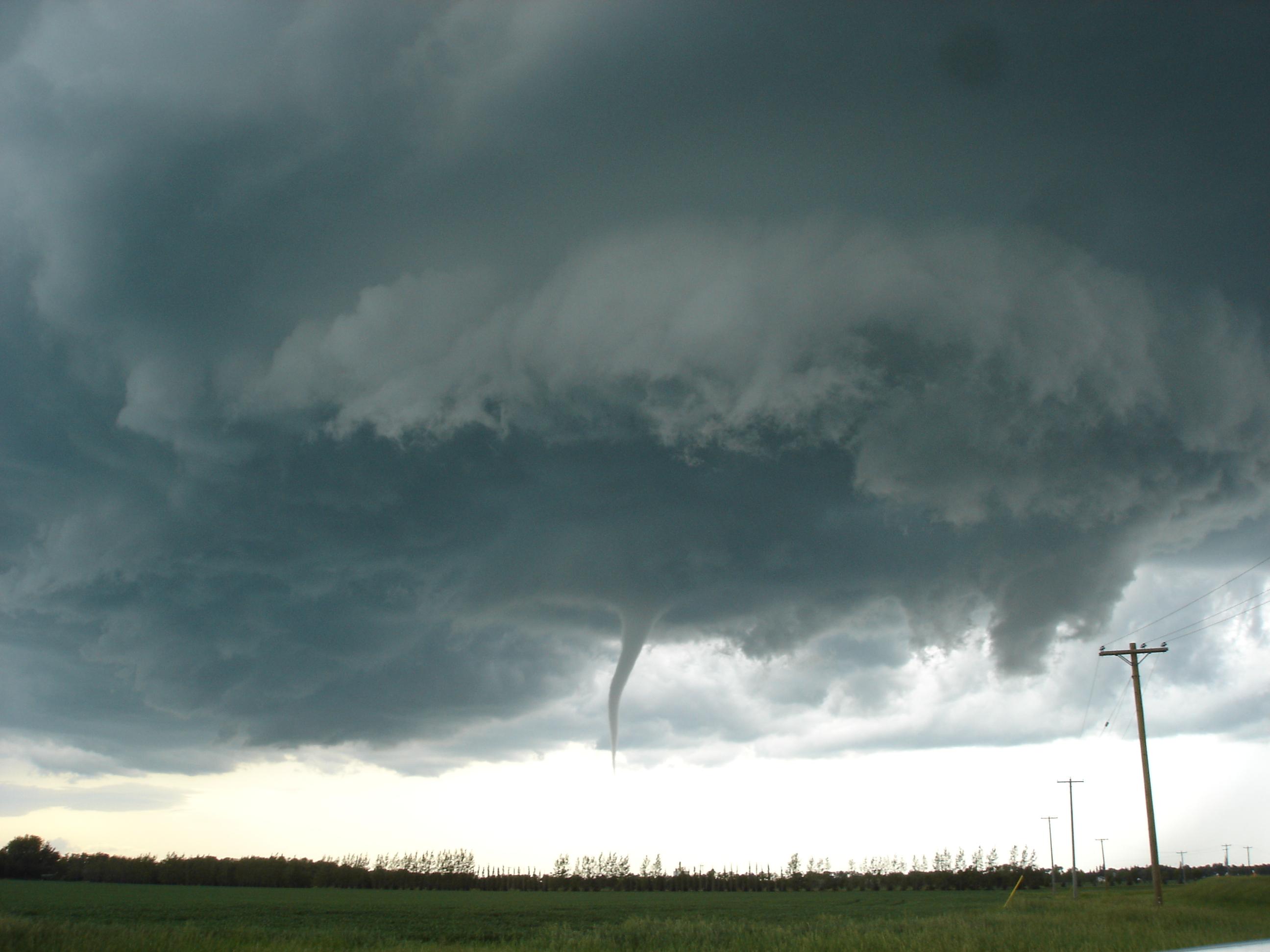 ; Accessory clouds:
:; Pannus: Latin for "shredded cloth": A ragged or shredded accessory cloud that forms in precipitation below the main cloud.
; Accessory clouds:
:; Pannus: Latin for "shredded cloth": A ragged or shredded accessory cloud that forms in precipitation below the main cloud.
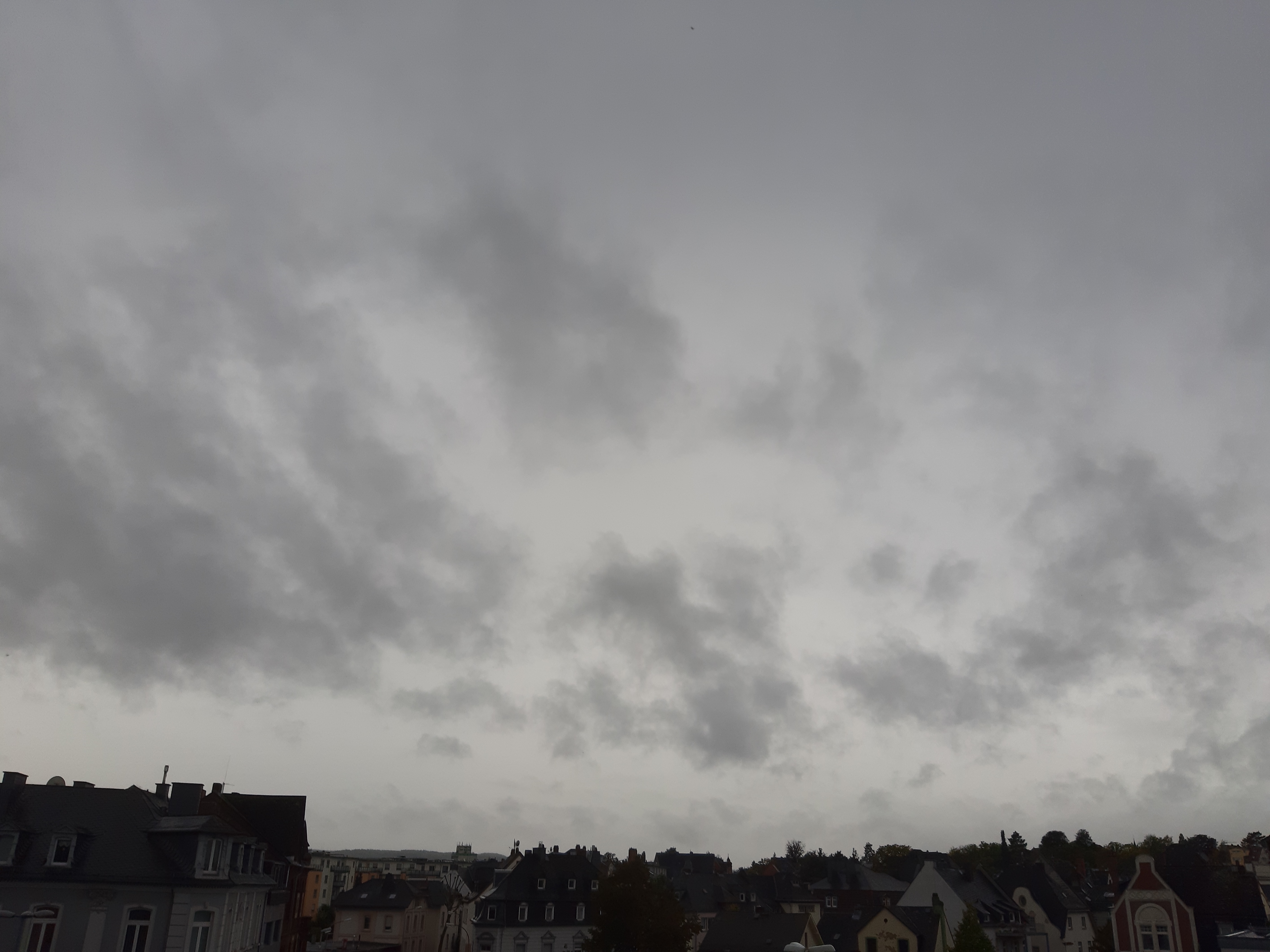 :; Pileus: "Capped": A hood-shaped accessory cloud.
:; Pileus: "Capped": A hood-shaped accessory cloud.
 :; Velum: "A ship's sail": An accessory cloud in the form of a sail.
:; Velum: "A ship's sail": An accessory cloud in the form of a sail.
 The supplementary features are associated with particular genera as follows. They are sorted from left to right in approximate decreasing order of frequency of occurrence for each of three categories. The genus types and some sub-types are arranged from top to bottom in approximate descending order of average overall altitude range. Each box is marked where a particular genus or sub-type has a particular supplementary feature.
The supplementary features are associated with particular genera as follows. They are sorted from left to right in approximate decreasing order of frequency of occurrence for each of three categories. The genus types and some sub-types are arranged from top to bottom in approximate descending order of average overall altitude range. Each box is marked where a particular genus or sub-type has a particular supplementary feature.
Genitus mother clouds
; Altocumulogenitus: Formed by the partial transformation of altocumulus mother cloud. ; Altostratogenitus: Formed by the partial transformation of altostratus. ; Cirrogenitus: Partial transformation of cirrus. ; Cirrocumulogenitus: Partial transformation of cirrocumulus. ; Cirrostratogenitus: Partial transformation of cirrostratus. ; Cumulogenitus: Spreading out or partial transformation of cumulus. ; Cumulonimbogenitus: Spreading out or partial transformation of cumulonimbus. ; Nimbostratogenitus: Partial transformation of nimbostratus. ; Stratogenitus: Partial transformation of stratus. ; Stratocumulogenitus: Partial transformation of stratocumulus.Other genitus clouds
; Cataractagenitus (cataracta-/pertaining to a river cataract): Formed from the mist at a waterfall, the downdraft caused from the cloud is counteracted by the ascending air displacement from the waterfall and may go on to form other types of clouds such as ''cumulus cataractagenitus''. ; Flammagenitus (flamma-/pertaining to fire): Formed by convection associated with large wildfires. ;Mutatus mother clouds
Nomenclature works the same way as for genitus mother clouds except for the ''mutatus'' suffix to indicate the ''complete'' rather than the partial transformation of the original cloud type. e.g. Altocumulomutatus – formed by the complete transformation of altocumulus mother cloud. The possible combinations of genera and mother clouds can be seen in this table. The genitus and mutatus clouds are each sorted from left to right in alphabetical order. The genus types and some sub-types are arranged from top to bottom in approximate descending order of average overall altitude range. Each box is marked where a particular genus or sub-type has a particular genitus or mutatus mother cloud.Informal terms recently accepted for WMO classification with Latin nomenclature
; Aviaticus cloud: Persistent condensation trails (contrails) formed by ice crystals originating from water vapor emitted by aircraft engines. Usually resembles cirrus; recognized as a WMO genitus cloud cirrus ''homogenitus'' (man-made). Further transformation into cirrus, cirrocumulus, or cirrostratus homomutatus is possible depending on atmospheric stability and wind shear. ;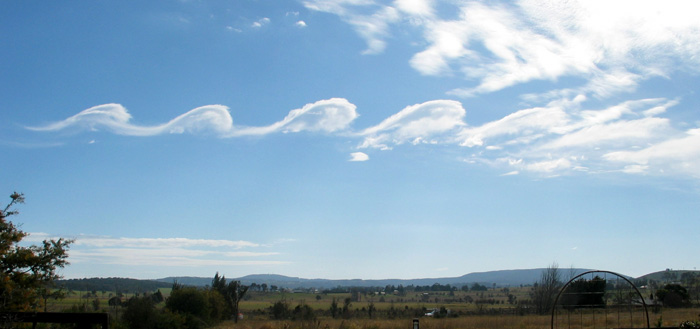 Crested wave-like clouds formed by wind-shear instability that may occur at any altitude in the troposphere. Accepted as a WMO supplementary feature with the Latin name ''fluctus''.
; Pyrocumulus and
Crested wave-like clouds formed by wind-shear instability that may occur at any altitude in the troposphere. Accepted as a WMO supplementary feature with the Latin name ''fluctus''.
; Pyrocumulus and  Elongated, low-level, tube shaped, horizontal formation not associated with a parent cloud. Accepted as a WMO stratocumulus or altocumulus species with the Latin name ''volutus''.
Elongated, low-level, tube shaped, horizontal formation not associated with a parent cloud. Accepted as a WMO stratocumulus or altocumulus species with the Latin name ''volutus''.
WMO and informal terms related to free-convective cloud types and storms
*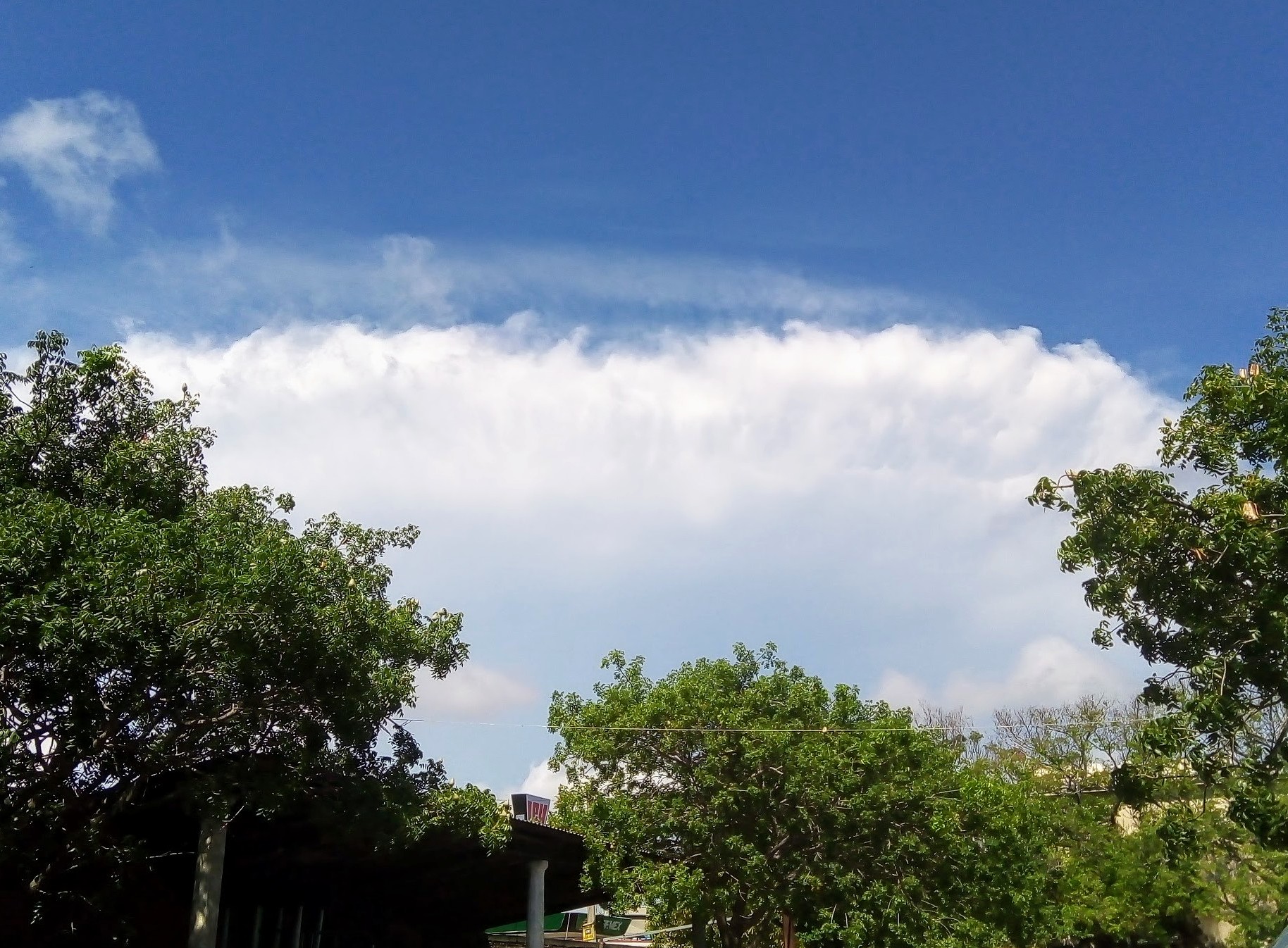 * Arcus cloud (WMO supplementary feature) – arch or a bow shape, attached to cumulus, thick with ragged edges.
*Backsheared anvil – (slang) anvil that spreads upwind, indicative of extreme weather.
*Clear slot or dry slot (informal term) – an evaporation of clouds as a rear flank downdraft descends and dries out cloud and occludes around a mesocyclone.
*Cloud tags (WMO species fractus) – ragged detached portions of cloud.
*Collar cloud (WMO velum accessory cloud) – ring shape surrounding upper part of wall cloud.
*Condensation funnel (WMO supplementary feature tuba) – the cloud of a funnel cloud aloft or a tornado.
*
* Arcus cloud (WMO supplementary feature) – arch or a bow shape, attached to cumulus, thick with ragged edges.
*Backsheared anvil – (slang) anvil that spreads upwind, indicative of extreme weather.
*Clear slot or dry slot (informal term) – an evaporation of clouds as a rear flank downdraft descends and dries out cloud and occludes around a mesocyclone.
*Cloud tags (WMO species fractus) – ragged detached portions of cloud.
*Collar cloud (WMO velum accessory cloud) – ring shape surrounding upper part of wall cloud.
*Condensation funnel (WMO supplementary feature tuba) – the cloud of a funnel cloud aloft or a tornado.
* *Cumulus tuba (WMO genus and supplementary feature) – column hanging from the bottom of cumulus.
* Cumulonimbus (WMO genus) – heaped towering rain-bearing clouds that stretch to the upper levels of the troposphere.
* Cumulonimbus calvus (WMO genus and species) – cumulonimbus with round tops like cumulus congestus.
* Cumulonimbus capillatus (WMO genus and species) – Cb with cirriform top.
*
*Cumulus tuba (WMO genus and supplementary feature) – column hanging from the bottom of cumulus.
* Cumulonimbus (WMO genus) – heaped towering rain-bearing clouds that stretch to the upper levels of the troposphere.
* Cumulonimbus calvus (WMO genus and species) – cumulonimbus with round tops like cumulus congestus.
* Cumulonimbus capillatus (WMO genus and species) – Cb with cirriform top.
*Other planets
Venus
Thick overcast clouds ofMars
Clouds resembling several terrestrial types can be seen over Mars and are believed to be composed of water- ice. ; Extremely high cirriform: Noctilucent clouds are known to form near the poles at altitudes similar to or higher than the same type of clouds over Earth. ; High cirriform: Thin scattered wispy cloud resembling cirrus through which the planet's surface can be seen. ; High stratocumuliform: Thin scattered wave-cloud resembling cirrocumulus. ; Low stratocumuliform: Wave-cloud resembling stratocumulus, especially as a polar cap cloud over the winter pole which is mostly composed of suspended frozen carbon dioxide. ; Surface-based: Morning fog of water and/or carbon dioxide commonly forms in low areas of the planet.Jupiter and Saturn
Cloud decks in parallel latitudinal bands at and below the tropopause alternately composed of ammonia crystals andUranus and Neptune
Cloud layers composed mainly of methane gas. ; Cirriform: High wispy formations resembling cirrus. ; Stratiform: Layers of haze-cloud that lack any distinct features. ; Cumuliform and cumulonimbiform: Lower-based convective clouds that can produce thunderstorms.See also
*Notes and references
External links
Introduction to Clouds (National Weather Service)
(in Polish)
NOAA
{{DEFAULTSORT:List Of Cloud Types Satellite interpretation lv:Mākoņu veidu uzskaitījums pl:Chmura#Klasyfikacja chmur